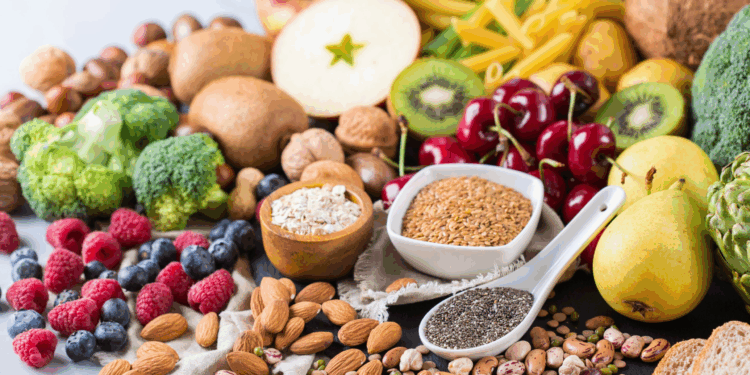In the ever-growing world of weight loss advice, we hear a lot about proteins, carbs, and fats—but often, fiber is left behind. It’s not flashy. It doesn’t come with colorful packaging or catchy slogans. Yet, if you’ve been struggling to shed those stubborn pounds, fiber might be the silent hero you’ve been ignoring.
Recently, registered dietitian Lisa Valente, MS, RD sat down to answer common questions about fiber’s role in health and weight loss. Her insights challenge what we often assume about nutrition and offer practical tips for anyone looking to eat better, feel fuller, and lose weight sustainably.
Let’s explore what fiber does, how it can help with weight loss, whether supplements are as good as whole foods, and which foods to prioritize for maximum benefit.
What Is Fiber and Why Does It Matter?
Fiber is a type of carbohydrate that the body can’t digest. Instead of being broken down into sugar, it passes through the digestive tract, helping regulate everything from bowel movements to blood sugar levels.
There are two types:
-
Soluble fiber, which dissolves in water to form a gel-like substance. It helps lower cholesterol and regulate blood sugar.
-
Insoluble fiber, which adds bulk to stool and helps food pass more quickly through the stomach and intestines.
Both types play a vital role in health — and especially in weight loss.
Can Fiber Help You Lose Weight?
According to Valente and recent research, yes — fiber can support weight loss, but not in the way a magic pill might. Instead, it works with your body to create the conditions for healthy eating and digestion:
-
Fiber keeps you full longer. This reduces mindless snacking and overeating.
-
It slows digestion, helping regulate blood sugar and insulin spikes.
-
High-fiber foods are less calorie-dense, meaning you can eat more and feel full with fewer calories.
Some are even calling it “Nature’s Ozempic” due to its appetite-regulating qualities — but Valente clarifies that while fiber is powerful, it’s not a prescription drug substitute. Rather, it’s a natural tool to support better habits.
Are You Eating Enough Fiber?
Probably not.
Studies show less than 5% of Americans meet their daily fiber intake goals.
Recommended daily intake:
-
Men: 30–34 grams
-
Women: 25–28 grams
That’s a lot more than most people get, especially those following high-protein or low-carb diets, which often lack whole grains, legumes, fruits, and vegetables — the main sources of fiber.
Valente suggests tracking your intake for a few days to see where you fall short. “Chances are,” she says, “you’ll find you’re not getting enough.”
Fiber Supplements vs. Whole Foods: What Works Better?
Fiber supplements like psyllium husk or inulin can help, but whole foods offer additional nutrients and tend to have better satiety effects.
“Supplements can be helpful if you’re not meeting your needs through diet,” Valente says, “but they shouldn’t replace fiber-rich foods.”
Why? Because real foods give you vitamins, minerals, antioxidants, and hydration — all of which play a part in overall health and metabolism.
Lisa Valente’s Top 3 High-Fiber Food Picks
When asked for her favorite fiber-rich options, Valente gave three go-to foods that are easy to integrate into daily meals:
1. Frozen Berries
Surprisingly, frozen berries have even more fiber than fresh ones — and they’re budget-friendly, easy to store, and great in smoothies, oatmeal, or yogurt.
“They don’t go bad in a day, and they’re affordable. A win-win,” says Valente.
2. Whole Wheat Pasta
Think brown rice is a good fiber source? Whole wheat pasta is better. It offers more fiber per gram and serves as a perfect base for balanced meals.
“Add veggies and protein, and you’ve got a fiber-rich dinner,” she adds.
3. Chia Seeds
Tiny but mighty. Chia seeds are a nutritional powerhouse — packed with fiber, omega-3s, and plant protein.
“I sprinkle them on oatmeal or make chia pudding. They’re incredibly filling,” says Valente.
Fiber and Insulin Resistance: What’s the Link?
Fiber may also help regulate blood sugar and improve insulin sensitivity, both crucial for people with pre-diabetes, type 2 diabetes, or PCOS.
Soluble fiber slows the absorption of sugar, preventing large insulin spikes. This makes it a valuable part of any diet targeting metabolic health or weight management.
How to Add More Fiber to Your Diet (Without the Bloat)
If you’re not used to eating fiber, start slow. Increasing fiber too quickly can cause gas, bloating, or discomfort.
Tips to boost fiber:
-
Start with one high-fiber food per meal
-
Drink plenty of water — fiber works best when hydrated
-
Snack on nuts, fruits, or air-popped popcorn
-
Choose whole grains over white or refined ones
Final Thoughts: Is Fiber the Missing Key?
Fiber isn’t trendy. It’s not flashy. But it’s one of the most powerful and underrated tools in any health journey. Whether you’re trying to lose weight, improve digestion, or balance your blood sugar, adding more fiber could make a significant difference.
So before reaching for expensive detoxes or cutting out entire food groups, start with fiber. It’s simple, affordable, and incredibly effective.
For more expert-backed health tips and science-based wellness insights, visit Desert Feed.




